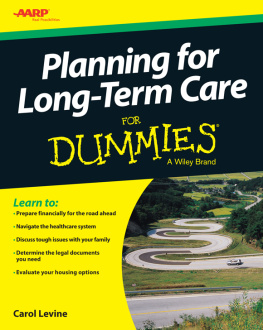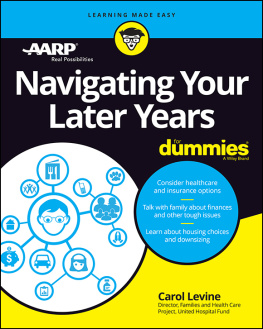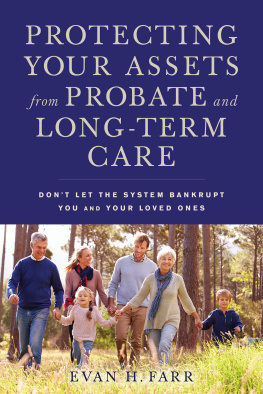American Association of Retired Persons. - Planning For Long-Term Care For Dummies
Here you can read online American Association of Retired Persons. - Planning For Long-Term Care For Dummies full text of the book (entire story) in english for free. Download pdf and epub, get meaning, cover and reviews about this ebook. City: Hoboken;NJ, year: 2014, publisher: AARP, John Wiley & Sons, genre: Home and family. Description of the work, (preface) as well as reviews are available. Best literature library LitArk.com created for fans of good reading and offers a wide selection of genres:
Romance novel
Science fiction
Adventure
Detective
Science
History
Home and family
Prose
Art
Politics
Computer
Non-fiction
Religion
Business
Children
Humor
Choose a favorite category and find really read worthwhile books. Enjoy immersion in the world of imagination, feel the emotions of the characters or learn something new for yourself, make an fascinating discovery.
- Book:Planning For Long-Term Care For Dummies
- Author:
- Publisher:AARP, John Wiley & Sons
- Genre:
- Year:2014
- City:Hoboken;NJ
- Rating:3 / 5
- Favourites:Add to favourites
- Your mark:
- 60
- 1
- 2
- 3
- 4
- 5
Planning For Long-Term Care For Dummies: summary, description and annotation
We offer to read an annotation, description, summary or preface (depends on what the author of the book "Planning For Long-Term Care For Dummies" wrote himself). If you haven't found the necessary information about the book — write in the comments, we will try to find it.
American Association of Retired Persons.: author's other books
Who wrote Planning For Long-Term Care For Dummies? Find out the surname, the name of the author of the book and a list of all author's works by series.
Planning For Long-Term Care For Dummies — read online for free the complete book (whole text) full work
Below is the text of the book, divided by pages. System saving the place of the last page read, allows you to conveniently read the book "Planning For Long-Term Care For Dummies" online for free, without having to search again every time where you left off. Put a bookmark, and you can go to the page where you finished reading at any time.
Font size:
Interval:
Bookmark:

Planning For Long-Term Care For Dummies
Published by: John Wiley & Sons, Inc., 111 River Street, Hoboken, NJ 07030-5774, www.wiley.com
Copyright 2014 by AARP. All rights reserved. AARP is a registered trademark.
Published simultaneously in Canada
No part of this publication may be reproduced, stored in a retrieval system or transmitted in any form or by any means, electronic, mechanical, photocopying, recording, scanning or otherwise, except as permitted under Sections 107 or 108 of the 1976 United States Copyright Act, without the prior written permission of the Publisher. Requests to the Publisher for permission should be addressed to the Permissions Department, John Wiley & Sons, Inc., 111 River Street, Hoboken, NJ 07030, (201) 748-6011, fax (201) 748-6008, or online at http://www.wiley.com/go/permissions .
Trademarks: Wiley, For Dummies, the Dummies Man logo, Dummies.com, Making Everything Easier, and related trade dress are trademarks or registered trademarks of John Wiley & Sons, Inc., and may not be used without written permission. AARP is a registered trademark of AARP, Inc. All other trademarks are the property of their respective owners. John Wiley & Sons, Inc., is not associated with any product or vendor mentioned in this book.
LIMIT OF LIABILITY/DISCLAIMER OF WARRANTY: WHILE THE PUBLISHER, AARP, AND THE AUTHOR HAVE USED THEIR BEST EFFORTS IN PREPARING THIS BOOK, THEY MAKE NO REPRESENTATIONS OR WARRANTIES WITH RESPECT TO THE ACCURACY OR COMPLETENESS OF THE CONTENTS OF THIS BOOK AND SPECIFICALLY DISCLAIM ANY IMPLIED WARRANTIES OF MERCHANTABILITY OR FITNESS FOR A PARTICULAR PURPOSE. NO WARRANTY MAY BE CREATED OR EXTENDED BY SALES REPRESENTATIVES OR WRITTEN SALES MATERIALS. THE ADVICE AND STRATEGIES CONTAINED HEREIN MAY NOT BE SUITABLE FOR YOUR SITUATION. YOU SHOULD CONSULT WITH A PROFESSIONAL WHERE APPROPRIATE. IF PROFESSIONAL ASSISTANCE IS REQUIRED, THE SERVICES OF A COMPETENT PROFESSIONAL PERSON SHOULD BE SOUGHT. THE PUBLISHER, AARP, AND THE AUTHOR SHALL NOT BE LIABLE FOR DAMAGES ARISING HEREFROM. THE FACT THAT AN ORGANIZATION OR WEBSITE IS REFERRED TO IN THIS WORK AS A CITATION AND/OR A POTENTIAL SOURCE OF FURTHER INFORMATION DOES NOT MEAN THAT THE PUBLISHER, AARP, OR THE AUTHOR ENDORSE THE INFORMATION THE ORGANIZATION OR WEBSITE MAY PROVI! DE OR RECOMMENDATIONS IT MAY MAKE. FURTHER, READERS SHOULD BE AWARE THAT INTERNET WEBSITES LISTED IN THIS WORK MAY HAVE CHANGED OR DISAPPEARED BETWEEN WHEN THIS WORK WAS WRITTEN AND WHEN IT IS READ.
For general information on our other products and services, please contact our Customer Care Department within the U.S. at 877-762-2974, outside the U.S. at 317-572-3993, or fax 317-572-4002. For technical support, please visit www.wiley.com/techsupport .
Wiley publishes in a variety of print and electronic formats and by print-on-demand. Some material included with standard print versions of this book may not be included in e-books or in print-on-demand. If this book refers to media such as a CD or DVD that is not included in the version you purchased, you may download this material at http://booksupport.wiley.com . For more information about Wiley products, visit www.wiley.com .
This and other AARP books are available in print and e-formats at AARPs online bookstore, www.aarp.org/bookstore , and through local and online bookstores.
Library of Congress number is available upon request.
ISBN: 978-1-118-72575-7 (pbk); ISBN 978-1-118-75650-8 (ebk); ISBN 978-1-118-75654-6 (ebk); ISBN 978-1-118-75660-7 (ebk)
Manufactured in the United States of America
10 9 8 7 6 5 4 3 2 1
Chapter 1
In This Chapter
 Defining long-term care broadly
Defining long-term care broadly
 Seeing the changes and new options
Seeing the changes and new options
 Selecting good advisors
Selecting good advisors
Just by opening this chapter, you have become a member of a select group of people who are taking a big step toward a better future for yourself and your family. Most studies show that only a third of Americans have made even the most basic plans for their future care needs. Perhaps you are already facing this dilemma for an aging or sick parent who lacks a plan for the long term and so you know how important it is to consider the future.
Thinking about the many aspects to consider from finances to health to housing to more is emotionally difficult, but it is also intellectually challenging because the choices available are often not clear-cut. They may involve complex financial calculations as well as personal and family preferences. But ignoring the question only makes the day of reckoning that much more difficult. In this chapter I help you start to think about long-term care in a proactive and positive way.
Long-term care is different for each individual and ideally should be tailored to a person's needs and preferences. I want to reinforce this notion: Long-term care does not start with a place or a payment mechanism or a set of services; it starts with a person.
Many conventional definitions, however, start with a different focus what services are included, who provides them, where they are provided, and, most important, who pays (or won't pay) the bill. These factors are obviously important, but they should not overshadow the person at its center.
In addition to being person-centered, planning should start early at a point when various options for living at home or in a community can be arranged that prolong independence and make it less likely that institutional care will be needed. From that perspective, modifying your home to make it safer and more accessible is part of a long-term care plan. So is considering the possibility of multigenerational living and various forms of group residence in the community. These options are discussed in Part .
The chapters in Part has a chapter on common myths about aging and long-term care and one on using websites with state-by-state information, valuable because so much of long-term care is determined by state, not federal policies. Appendix A is a glossary of terms you may encounter, and Appendix B is a list of resources. Throughout this book I reinforce the idea that a long-term care plan is not just about where you live or what services you get but about how you want to live and how to achieve your goals.
Defining long-term care is, perhaps surprisingly, not straightforward. Many people in the field of aging consider long-term care to be services that are nonmedical, such as personal care (bathing, dressing, feeding) or household tasks (shopping, cooking, transportation). Although these aspects of assistance are essential, in this book I take a broader view to include factors like medical care, housing options, financial considerations, advance care planning, and the community environment. I believe that when considering long-term care, most people should look at the whole spectrum of need rather than only specific segments.
 In its 2013 overview of long-term care service providers, the National Center for Health Statistics found that about 58,500 providers served about 8 million people in the United States. These included 4,800 adult day services, 12,200 home health agencies, 3,700 hospices, 15,700 nursing homes, and 22,200 assisted living and other residential care communities. The majority in four of these five sectors were for-profit organizations. Only adult day services were mostly nonprofit. While these numbers may seem large, they do not include the family caregivers who provide unpaid care to the vast majority of older adults who need long-term assistance. The full report is available at http://www.cdc.gov/nchs/data/nsltcp/long_term_care_services_2013.pdf .
In its 2013 overview of long-term care service providers, the National Center for Health Statistics found that about 58,500 providers served about 8 million people in the United States. These included 4,800 adult day services, 12,200 home health agencies, 3,700 hospices, 15,700 nursing homes, and 22,200 assisted living and other residential care communities. The majority in four of these five sectors were for-profit organizations. Only adult day services were mostly nonprofit. While these numbers may seem large, they do not include the family caregivers who provide unpaid care to the vast majority of older adults who need long-term assistance. The full report is available at http://www.cdc.gov/nchs/data/nsltcp/long_term_care_services_2013.pdf .
Font size:
Interval:
Bookmark:
Similar books «Planning For Long-Term Care For Dummies»
Look at similar books to Planning For Long-Term Care For Dummies. We have selected literature similar in name and meaning in the hope of providing readers with more options to find new, interesting, not yet read works.
Discussion, reviews of the book Planning For Long-Term Care For Dummies and just readers' own opinions. Leave your comments, write what you think about the work, its meaning or the main characters. Specify what exactly you liked and what you didn't like, and why you think so.









